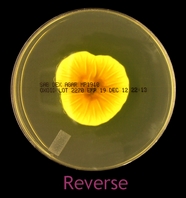Penicillium
Ah, the lowly genus Penicillium; a few words and photos…
The genus Penicillium has upwards of 300 identifiable species most of which are considered to be contaminants rather than pathogens when encountered in the clinical laboratory. The exception is Penicillium marneffei, which is unique amongst the Penicillium species as it can exhibit thermal dimorphism (ie. temperature dependent Yeast-like or filamentous forms). It is capable of causing cutaneous infections as well as invading the spleen, liver and bones. While P.marneffei is usually isolated from immunocompromised individuals, immunocompetent persons may also become infected. P.marneffei is most frequently found in South East Asia (South-eastern China, Myanmar, Laos & Thailand) and has been isolated from visitors to that region. While systemic infections with other species of Penicillium are unlikely, they have been recovered from respiratory & urinary tract specimens as well as from corneal scrapings. As with other fungi previously considered contaminants, Penicilliumspecies should be opportunistic and capable of causing infection in the severely debilitated patient.
Many species of Penicillium produce mycotoxins or by-products which can be detrimental (eg citreoviridin, ochratoxin), while others beneficial (eg. mycophenolic acid,rubratoxins) [i]. Of course the antibiotic Penicillin is derived from the name Penicillium. It was in 1928 that Alexander Flemming observed that a culture of Penicillium rubens exuded a substance which inhibited certain bacteria – the birth of antibiotic therapy.
Ecology: This ubiquitous fungus, capable of tolerating a wide range of climates, is found predominantly in regions that have a temperate climate. Penicillium species can be found in soils, decaying vegetation, grains and food stuffs.
 Macroscopic: Most species exhibit rapid growth and become fully mature in about 5 days. The surface appearance is usually described as velvety to powdery. The colony colour varies with the species but is usually a green, blue-green or grey-green, often with a white edge. Exudates of various colours may also form on the surface. The reverse usually a pale cream to yellow but may be a more intense reddish-brown. An exception is P.marneffei which can produce a red surface coloration that can diffuse into the medium.
Macroscopic: Most species exhibit rapid growth and become fully mature in about 5 days. The surface appearance is usually described as velvety to powdery. The colony colour varies with the species but is usually a green, blue-green or grey-green, often with a white edge. Exudates of various colours may also form on the surface. The reverse usually a pale cream to yellow but may be a more intense reddish-brown. An exception is P.marneffei which can produce a red surface coloration that can diffuse into the medium.Penicllium species on SAB media. Many species are rapid growing however the one pictured above was photographed at day 7 at 30oC
Microscopic:Penicillium produces septate, hyaline hyphae, about 1.5 µm to 5 µm in diameter. Conidiophores can be simple or branched depending on the species. They are described as Monoverticillate (phialides extend directly from the hyphae), Biverticillate (phialides extend from branches which extend from the hyphae), or Terviticillate (phialides extend from structures called metulae, appearing as secondary branches, which extend from primary branches extending from the hyphae) –make sense? Phialides produce the conidia, together with the metulae and the branches can be considered the conidiophore. Phialides are, to a greater or lesser degree, flask or ampule shaped depending on the species. The phialides produce smooth or rough, single celled conidia (~2.5 µm to 5µm) which extend as basipetal chains. Conidia can vary in shape from spherical to ovoid to fusiform, again dependant on the species. The entire structure, conidiophore and extending conidia resemble a ‘brush’ or penicillus (Latin), from which the genus name was derived.
Penicillium structures which are used in identification/classification of the species
Penicillium species - just one example of the many Penicillium species. Rather hefty phialides as compared to the delicate, tapering phialides of Paecilomyces species. Rough conidia produced by this species.
(LPCB, 1000X, DMD-108)
Penicillium species - got a great photo, but it does show the septate hyphae and conidiophores. This species appears to be biverticillate in structure.
(LPCB, 1000X, DMD-108)
Penicillium species (LPCB, 1000X, DMD-108)
Penicillium species (LPCB, 1000X, DMD-108)
Penicillium species - More of the same, just pretty pictures. Note micron bar in upper right of photo. (LPCB, 1000X, DMD-108)
Penicillium species - Phialides taper somewhat towards the apex where this species produces chains of rough-walled conidia.
(LPCB, 1000X, DMD-108)
Penicillium species can be differentiated from Paecilomycesspecies as the later has long, pointed apical extensions to the phialides. In my opinion, this gives Paecilomyces a somewhat more elegant or delicate appearance. The longer phialides of Paecilomyces appear to splay out, away from the conidiophore, much more than the rather straight phialides of Penicillium (a trident vs. pitchfork). Penicillium also bears some resemblance to Gliocladium species however Penicilliumspecies produce chains of conidia while Gliocladiumspecies’ conidia accumulate as a ball at the apex of the conidiophore. It differs from Scopulariopsis species by forming phialides.








